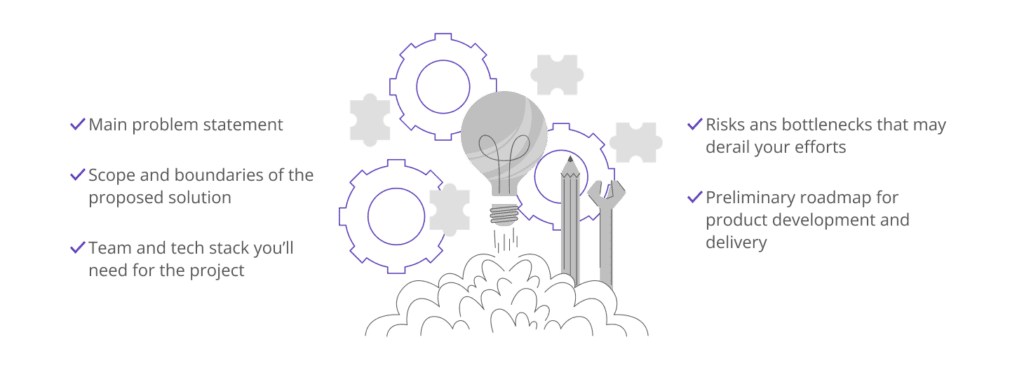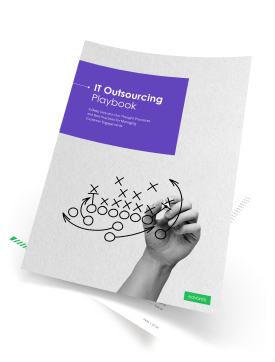If you were asked to break-down your new software product into a set of requirements, could you easily do that, or you wouldn’t be able to move past the highest level of abstraction?
The above is a hard task, especially when you are early into your product development journey. However, if you want to move from a “vision” to a market-ready product, you’ll need to know how to communicate your product vision as a list of precise requirements. The discovery phase is meant to facilitate that.
What is a Discovery Phase in IT Projects?
A discovery phase is a pre-development phase of an IT project, designed to clarify requirements and develop a product roadmap.
Discovery phase typically includes a set of meetings where you and your vendor get a “headspace” to formalize your software product vision and put down all the necessary functional and non-functional requirements. It’s a critical step for determining the optimal approach to software development.
At Edvantis, we consider the discovery phase as an optional step (with the exception of the Fixed-price Project service model). You may opt out of the discovery phase if you reach out to us with a well-defined project vision: formalized technical requirements, detailed scope of work, and a preferred tech stack and team composition.
However, if you’re still ironing out the deets, doing IT discovery can help you systematize all the ideas and organize them into product development plans.
A well-performed IT discovery research helps you frame:
- Main problem statement
- Scope and boundaries of the proposed solution
- Team and tech stack you’ll need for the project
- Risks and bottlenecks that may derail your efforts
- Preliminary roadmap for product development and delivery
Discovery Phase Deliverables:

Two Types of Discovery Phases
If you have ever organized a sit-down session with your team (or an outsourcing partner) to collect data for the project and prioritize different requirements, you’ve already done some form of IT discovery.
There are cases, however, when either you or your vendor have to formally request the discovery phase to explore the project specifications in greater detail.
Respectively, the discovery phases can happen in two ways: organically or intentionally.
Organic Discovery
Organic discovery occurs when both you and your IT outsourcing partner acknowledge that there is a need for clarifying project requirements and begin to exchange information. It is a natural part of co-creation — one of the key principles of how we work at Edvantis.
Co-creation in IT stands for proactive knowledge sharing and involvement of your IT partner in both the ideation processes and development process. Rather than trying to get all answers in-house, businesses tap into the vendor’s outside perspective and technical know-how to gain innovative suggestions and unbiased assumptions.
Intentional Discovery
International discovery, on the other hand, is a more formal request, typically voiced out by the vendor when they need to collect extra data around the product specs, deliverables, and other business requirements.
Formal discovery sessions are the cornerstone to the successful delivery of Fixed-price Projects — scoped, end-to-end outsourcing engagements with a set list of deliverables.
The formal discovery process relies on structured business analysis activities such as:
- Stakeholder and end-user interviews
- Product scoping and feature prioritization
- Product architecture analysis or design
- Backlog preparation
The above actions help both parties develop a shared understanding of jobs-to-be-done and provide a time and budget estimation for the development.
How Does Discovery Phase Benefit Software Projects?
IT discovery phase is meant to set proper expectations on both sides pre-engagement and align the two companies on the shared objectives. So that at the end of the planned software development life cycle, you, as a client, would walk away with a product that fully meets your requirements.
From an outsourcing partner perspective, discovery is a crucial step to minimize the risks of:
- Budget overruns
- Extended timelines
- Sub-par product quality
- Unscoped work
- And subsequently — unmet expectations
At Edvantis, we host client discovery sessions for all Fixed-price Projects. But this step can drive positive outcomes for other types of engagements too.
Benefits of a Discovery Phase
When it comes to software development outsourcing and project co-creation process, there are several important benefits.
- Sharper business case and solutions vision. Structured analysis helps uncover all project risks and requirements and translate your lofty “vision” into a set of concrete steps, requirements, and deliverables. These, in turn, can be effectively communicated to everyone on your team. And subsequently, used to determine the optimal service model, team composition, scope and priority of work, and work breakdown structure.
- Lower chances of budget and timeline overruns. Per PMI 2021 survey, 38% of IT projects exceeded budget, and 45% fell behind schedule. Software projects have become significantly more complex, whereas the practices of requirements gathering and formalization remain underused. Discovery phase provides room and structure for defining the scope and subsequently mitigating the risks of overruns.
- Risk assessment and mitigation. Apart from gaining a list of project requirements and deliverables, you can also use the discovery phase as an opportunity to get a second opinion on your tech architecture and tech stack. An experienced IT partner will draw attention to any weaknesses in your infrastructure capabilities, possible incompatibilities, and potential tech or operational constraints. By having this data, you can identify potential project risks and take proactive steps to mitigate them.
IT Discovery Steps: What Happens After Filing a Formal Request?
As we go through the engagement process together, we naturally talk about project details, filling in the knowledge gaps and achieving a common project understanding.
However, when IT discovery is formally requested or occurs within Fixed-price Project service model (or both), Edvantis initiates a four-step procedure:
Step 1. Document the Available Project Information
You may already have some well-thought-out requirements or large-scale ideas in mind before our meeting. We’ll need to capture that vision to:
- Know what questions to furtherly ask you
- Assemble the optimal discovery team
- Select relevant case studies for references
- Define the initial scope of the project
During this step, we aim to evaluate your ideas, initial requirements, research results, past experiences, reference cases, etc. Your input will drive the discovery phase, so open and proactive communication is essential. Based on this knowledge exchange, we’ll transcribe your idea into specific software requirements — then suggest the optimal path forward for delivery. To ensure secure information exchange, we encourage all clients to countersign NDAs prior to doing any IT discovery activities.
Step 2. Assemble the Discovery Team
Based on the project type, we’ll appoint the right discovery team.
Although team composition varies from one project to another, the following people are typically present:
- UX Designer — helps collect and formulate non-functional requirements around product performance, usability, and main user flows.
- Business Analyst — assists with functional requirement gathering, clarification, and formalization. Helps spell out the requirements for every behavior and function of the proposed solution.
- Software Architect — assesses the current technical environments and infrastructures. Proposes the best-applicable software architecture design and technology stack.
- Account Manager — facilitates discussions with stakeholders, manages expectations, and proactively addresses any questions or concerns at this stage.
Since the discovery phase is a two-way engagement, you will also need to contribute to the conversation. From your side, the following people should assist Edvantis’ discovery team and be available for client discovery sessions:
- Key stakeholders — typically product management team or a dedicated Program Manager. Though we also frequently work with partners on the c-suite level. To keep the discussions productive, only involve stakeholders with decision-making power for this particular project.
- Business users — involve end-product users if you haven’t previously collected and prioritized a list of requirements.
- CTO or Senior Software Architect — their knowledge is essential for clarifying technical requirements.
Depending on your project requirements, we may add specialists with niche expertise to the discovery team (QA Engineers, SRE Specialists, DevOps Specialists, etc.).
Step 3. Hold a Set of Workshops
Now it’s time we schedule a series of virtual or in-person workshops with your team. They usually involve a general overview session, led by an expert from your end, and a follow-up Q&A session, where we pose further questions. We can also hold optional design and technical sessions. IT discovery workshops typically last between two and six hours.
The number and length of meetings will depend on your project’s complexity, what you have presented initially, and how many knowledge gaps you need to fill.
For efficient workshop sessions, we follow such general guidelines:
- Break down lengthy online discovery sessions into smaller ones to avoid burnout
- Schedule meetings according to the participants’ time zones
- Use secure virtual collaboration tools that fit all participants
- Thoroughly document each meeting and save it for future references
For more information on efficient workshops, read our previous blog post “Product Discovery Workshops: Gain Top Results in a Remote Setup”
Step 4. Finalize Discovery Phase Deliverables
The discovery phase helps validate earlier assumptions, pinpoint the risks and limitations of the proposed solution, and establish subsequent cooperation terms.
At Edvantis, we provide each client with a detailed discovery project report that includes the next deliverables.
Discovery Phase Deliverables:
Problem Statement — a succinct “snapshot” of the problems your solution will address.
Defined and prioritized scope of work (SOW) statement — a project roadmap, describing all the work requirements, specific deliverables, and timelines we can commit to. The document includes:
- List of functional and non-functional requirements
- High-level features prioritized (priority of work)
- Technical requirements and proposed tech stack
Key personnel resources and skillsets identified — an overview of roles, required at your side (typically at PM/PMO level), along with the jointly-approved team composition, and optimal IT service model.
Project risks, assumptions, and limitations — digitalization of the identified risks and constraints that may delay project kick-off or impact the development process if left unaddressed. We also proactively address any limitations, arising due to technical feasibility or other operational constraints.
Access to the information and expert insights will determine the level of details we can provide in the Discovery report. We’ll do our best when it comes to requirements elicitation, collection, and analysis. But we also expect proactive input from you.
To Conclude
The discovery phase helps frame the project requirements and lay the “groundwork” for the subsequent lag of SDLC — development. We use findings from the discovery stage to create the final Scope of Work agreements and move on to the next steps of the engagement process.
The data we together collect at this stage will provide extra context for many decisions that will be made during the later project stages. The better aligned and informed we both are – the better project outcomes we can reach together!
Still have questions left about the discovery phase or other steps in IT outsourcing? Contact one of our Account Managers.



